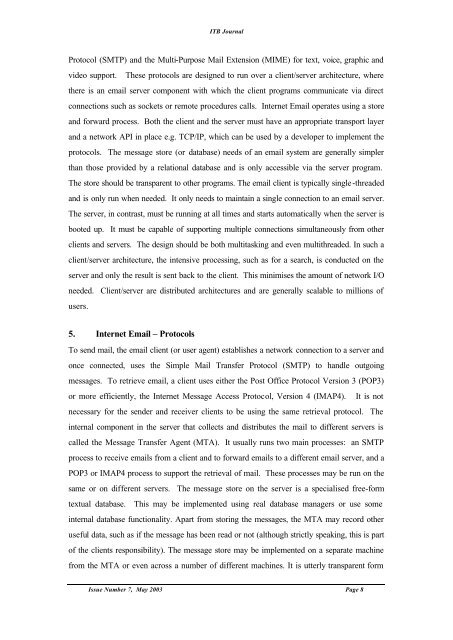ITB Journal-May-2003 - Institute of Technology Blanchardstown
ITB Journal-May-2003 - Institute of Technology Blanchardstown
ITB Journal-May-2003 - Institute of Technology Blanchardstown
Create successful ePaper yourself
Turn your PDF publications into a flip-book with our unique Google optimized e-Paper software.
<strong>ITB</strong> <strong>Journal</strong><br />
Protocol (SMTP) and the Multi-Purpose Mail Extension (MIME) for text, voice, graphic and<br />
video support. These protocols are designed to run over a client/server architecture, where<br />
there is an email server component with which the client programs communicate via direct<br />
connections such as sockets or remote procedures calls. Internet Email operates using a store<br />
and forward process. Both the client and the server must have an appropriate transport layer<br />
and a network API in place e.g. TCP/IP, which can be used by a developer to implement the<br />
protocols. The message store (or database) needs <strong>of</strong> an email system are generally simpler<br />
than those provided by a relational database and is only accessible via the server program.<br />
The store should be transparent to other programs. The email client is typically single-threaded<br />
and is only run when needed. It only needs to maintain a single connection to an email server.<br />
The server, in contrast, must be running at all times and starts automatically when the server is<br />
booted up. It must be capable <strong>of</strong> supporting multiple connections simultaneously from other<br />
clients and servers. The design should be both multitasking and even multithreaded. In such a<br />
client/server architecture, the intensive processing, such as for a search, is conducted on the<br />
server and only the result is sent back to the client. This minimises the amount <strong>of</strong> network I/O<br />
needed. Client/server are distributed architectures and are generally scalable to millions <strong>of</strong><br />
users.<br />
5. Internet Email – Protocols<br />
To send mail, the email client (or user agent) establishes a network connection to a server and<br />
once connected, uses the Simple Mail Transfer Protocol (SMTP) to handle outgoing<br />
messages. To retrieve email, a client uses either the Post Office Protocol Version 3 (POP3)<br />
or more efficiently, the Internet Message Access Protocol, Version 4 (IMAP4). It is not<br />
necessary for the sender and receiver clients to be using the same retrieval protocol. The<br />
internal component in the server that collects and distributes the mail to different servers is<br />
called the Message Transfer Agent (MTA). It usually runs two main processes: an SMTP<br />
process to receive emails from a client and to forward emails to a different email server, and a<br />
POP3 or IMAP4 process to support the retrieval <strong>of</strong> mail. These processes may be run on the<br />
same or on different servers. The message store on the server is a specialised free-form<br />
textual database. This may be implemented using real database managers or use some<br />
internal database functionality. Apart from storing the messages, the MTA may record other<br />
useful data, such as if the message has been read or not (although strictly speaking, this is part<br />
<strong>of</strong> the clients responsibility). The message store may be implemented on a separate machine<br />
from the MTA or even across a number <strong>of</strong> different machines. It is utterly transparent form<br />
Issue Number 7, <strong>May</strong> <strong>2003</strong> Page 8
















